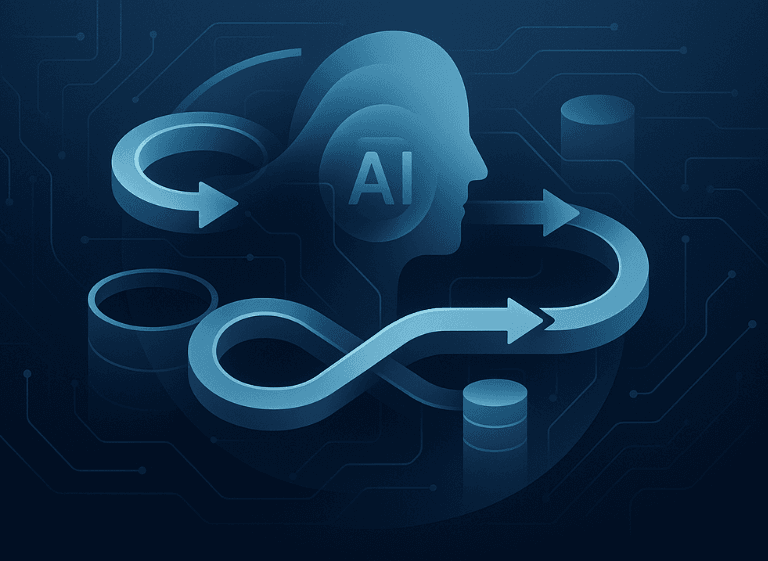Web Development
DevOps practices
AI tools
Security practices
AI for CI/CD Automation in Web Development
Nadiia Sidenko
2025-10-06
When release processes become unpredictable, engineering efficiency inevitably drops. Bringing AI tools into CI/CD makes releases transparent and fully controllable: automated pipelines remove repetitive work and reduce critical risks before production. That lets teams focus on user value. Early, measurable gains — like ~40% less manual work in the Notifix case — typically show up within a quarter. In this piece you’ll find a 90-day implementation plan, the DORA metrics to track, and a simple ROI method.

TL;DR
- AI-driven CI/CD makes releases predictable, shortens time-to-market, and lowers operational risk. Impact is visible within one quarter.
- What to measure: DORA (lead time, deployment frequency, change failure rate, MTTR) plus “cost per release.”
- What to implement: clear release rules, automated security/quality checks, SBOM for every release, and real-time visibility across environments.
Why AI-Driven CI/CD Matters for the Business
AI in web development makes releases faster and more predictable without piling work onto the team. Automation removes repetitive tasks, refocuses efforts on product value, and provides objective metrics to evaluate progress.
Within a quarter expect fewer failed releases, faster recovery after incidents, and a steadier delivery cadence — all of which affect revenue and reputation.
Three Decisions That Actually Speed Up Delivery
Release rules instead of relying on individual heroics. Define the checks required before merge, when automatic rollback triggers, and who gives the final go. This makes speed repeatable at the process level.
Risk visibility before release, not after an incident. Pre-release code and dependency checks plus an SBOM remove surprises in production. Fewer emergencies = more time for product work.
Measurement over opinions. Lead time, release frequency, failed-change rate, and MTTR provide ground truth for management decisions.
Example. A team shipped monthly and each release broke critical flows. After adding P0 tests for key scenarios, blocking merges until they passed, and piloting changes on a fraction of traffic with automatic rollback on thresholds, users stopped feeling the blast radius and the release cadence increased.
Who Owns What
Strategy and KPIs live at the leadership level. Implementation sits with engineering: wiring quality/security checks, collecting release artifacts, observability, and rollback process.
Principle: every step has a clear owner and a business outcome. For a steady 2025 cadence, baseline competencies include cloud, containers/Kubernetes, infrastructure as code, CI/CD, and observability — plus evolving AI team roles.
QA with AI: What Changes in 2025
Quality control moves directly into CI/CD: tests run on every commit and their status gates the release. API/contract tests grow in share because they’re faster and more stable than UI-only suites.
LLM-based tools help generate test cases from requirements and surface critical scenarios — a pattern echoed in broader QA automation trends.
Net effect: faster testing start-up and less manual work without sacrificing quality.
What to Track: DORA Metrics for Progress
For effective management, a few metrics are enough — the ones that tie to revenue, stability, and delivery speed.
| What to measure | Expected direction | Typical quarterly goal |
|---|---|---|
| Lead time (idea → release) | ↓ decrease | −30% |
| Deployment frequency | ↑ increase | ×2–×3 |
| Change failure rate | ↓ decrease | −25% |
| MTTR (time to restore) | ↓ decrease | < 1 hour |
| Engineer hours saved | ↑ increase | +N/week |
ROI Example: Numbers, Not Promises
Formula: ROI = (time saved × hourly cost × team size) − (licenses + implementation + support).
Conservative scenario: a 6-engineer team saves ~30 min/day via automation — part of the effect illustrated in the Notifix case (up to 58 min/engineer/day).
Calculation:
- 30 min × 6 people = 3 h/day ≈ 60 h/month
- At €40/h → ~€2,400/month saved
- Tools + implementation ≈ €1,200/month (first 3 months)
- Break-even from month 2
Plug in your rates and team size — the logic stays the same.
Notifix Case: A Business Story of CI/CD Automation
Problem. Teams spent too much time on manual release tasks and fragmented integrations, slowing updates and distracting engineers from product work.
Options considered.
- Local scripts per team — fast, but doesn’t scale
- Rigid “boxed” tool — low flexibility
- Lightweight platform tailored to existing processes with ready integrations
Business results. ~40% less manual CI/CD work, up to 58 min/engineer/day saved, stable releases under load, and clear visibility via automatic notifications and release artifacts. See details in the Notifix case.
Readiness Signals for Scaling
- Bottlenecks are obvious. You can name the top-3 process blockers without a workshop.
- Baseline metrics are visible. You know commit-to-release time, release frequency, and time to restore service.
- Risk thresholds are agreed. Everyone knows what blocks a merge and when rollback triggers — part of policy, not ad-hoc choices.
Where Delivery Speed Is Usually Lost (and Why)
Uncertainty eats time: decisions after the fact, passwords and tokens in personal notes, and rollback procedures invented during the incident.
Seemingly small things slow you down — manual steps in critical paths, fuzzy quality thresholds, and blurred ownership.
What works in practice: adopt a minimal set of release rules, centralize secret management, and ensure end-to-end service visibility at every stage.
Vendor Due-Diligence Questions (AI)
- Data residency. Where are our data stored, legally and physically? Can we pin to a region?
- Model training. Are our data/code used to train models without explicit consent?
- Reliability. Availability guarantees? Time to restore? Escalation path?
- Support. Response times, channels, SLOs, and relevant industry cases?
- Reporting. Do we get regular reports on release composition and discovered vulnerabilities?
90-Day Launch Plan
Phase 1 — Prepare (weeks 1–4)
- Capture baselines (lead time, frequency, change failure rate, MTTR), clean up access and secrets, align quality/rollback rules, and enable required checks in a pilot repo. Outcome: a clear starting point, fewer manual approvals, defined quality red lines. Gate: rollback policy and SBOM per release in place; baselines recorded.
Phase 2 — Pilot (weeks 5–10)
- Roll out a standard pipeline (build → test → dependency security → SBOM → safe deploy → notify), wire observability, gather team feedback. Outcome: steadier releases, engineers shift from chores to value, risks seen before release. Gate: deployment frequency ≥ ×2; failed changes trending down; mid-complexity config ~5 minutes.
Phase 3 — Measure & decide (weeks 11–13)
Compare metrics to the baseline, adjust policies, decide on scaling to more teams. Outcome: proven impact and a scalable plan without disruption. Targets: lead time −30%; MTTR < 1 hour; 2–3 releases/day (for high-update teams).
Technical Add-Ons (for Delegation)
- Pipeline steps: checks and artifacts per stage; report formats; SBOM requirements.
- Security checks: minimum code/dependency scanning, exception policy, scan result storage.
- Observability: what to collect (logs, metrics, traces), release labelling, basic SLO-based alerts (service-level objectives).
- Tool categories: CI/CD platform; code analysis; dependency scanning; SBOM; monitoring/logging; E2E testing.

FAQ
- How much does it cost to start? Time for a pilot plus 1–2 tool licenses. Typically comparable to the first 1–2 months of saved engineer hours.
- How long does implementation take? A realistic frame is 90 days: 3–4 prep, 4–6 pilot, 2–3 for measurement and scale-up decision.
- Main business risks? Misconfiguration can stall releases or introduce vulnerabilities. Mitigate with automated gates, a defined rollback process, and least-privilege access.
- How to get the team onboard? Show time saved (less repetitive work) and transparent progress metrics. 5. Start with 1–2 teams, gather feedback, then scale based on measured results.
- What if we don’t have a DevOps engineer? Start small: one repository, basic tests and checks, safe deploy with fast rollback, and automatic notifications. Expand coverage and complexity gradually.